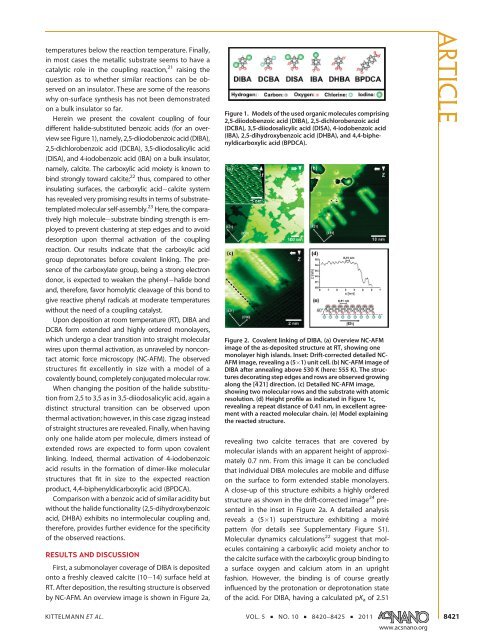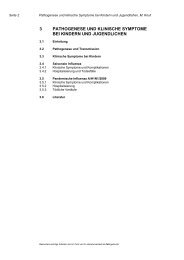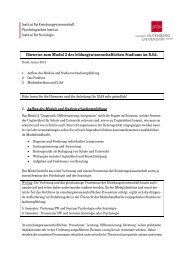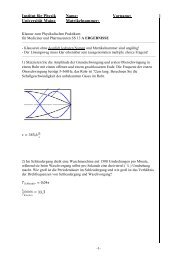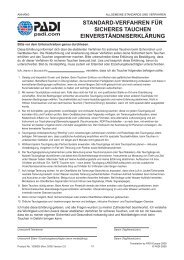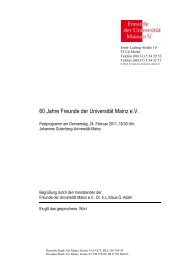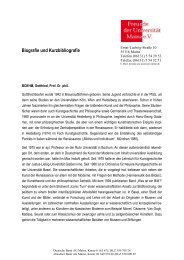KRN2011 - Johannes Gutenberg-Universität Mainz
KRN2011 - Johannes Gutenberg-Universität Mainz
KRN2011 - Johannes Gutenberg-Universität Mainz
Create successful ePaper yourself
Turn your PDF publications into a flip-book with our unique Google optimized e-Paper software.
temperatures below the reaction temperature. Finally,<br />
in most cases the metallic substrate seems to have a<br />
catalytic role in the coupling reaction, 21 raising the<br />
question as to whether similar reactions can be observed<br />
on an insulator. These are some of the reasons<br />
why on-surface synthesis has not been demonstrated<br />
on a bulk insulator so far.<br />
Herein we present the covalent coupling of four<br />
different halide-substituted benzoic acids (for an overview<br />
see Figure 1), namely, 2,5-diiodobenzoic acid (DIBA),<br />
2,5-dichlorobenzoic acid (DCBA), 3,5-diiodosalicylic acid<br />
(DISA), and 4-iodobenzoic acid (IBA) on a bulk insulator,<br />
namely, calcite. The carboxylic acid moiety is known to<br />
bind strongly toward calcite; 22 thus, compared to other<br />
insulating surfaces, the carboxylic acid calcite system<br />
has revealed very promising results in terms of substratetemplated<br />
molecular self-assembly. 23 Here, the comparatively<br />
high molecule substrate binding strength is employed<br />
to prevent clustering at step edges and to avoid<br />
desorption upon thermal activation of the coupling<br />
reaction. Our results indicate that the carboxylic acid<br />
group deprotonates before covalent linking. The presenceofthecarboxylategroup,<br />
being a strong electron<br />
donor, is expected to weaken the phenyl halide bond<br />
and, therefore, favor homolytic cleavage of this bond to<br />
give reactive phenyl radicals at moderate temperatures<br />
without the need of a coupling catalyst.<br />
Upon deposition at room temperature (RT), DIBA and<br />
DCBA form extended and highly ordered monolayers,<br />
which undergo a clear transition into straight molecular<br />
wires upon thermal activation, as unraveled by noncontact<br />
atomic force microscopy (NC-AFM). The observed<br />
structures fit excellently in size with a model of a<br />
covalently bound, completely conjugated molecular row.<br />
When changing the position of the halide substitution<br />
from 2,5 to 3,5 as in 3,5-diiodosalicylic acid, again a<br />
distinct structural transition can be observed upon<br />
thermal activation; however, in this case zigzag instead<br />
of straight structures are revealed. Finally, when having<br />
only one halide atom per molecule, dimers instead of<br />
extended rows are expected to form upon covalent<br />
linking. Indeed, thermal activation of 4-iodobenzoic<br />
acid results in the formation of dimer-like molecular<br />
structures that fit in size to the expected reaction<br />
product, 4,4-biphenyldicarboxylic acid (BPDCA).<br />
Comparison with a benzoic acid of similar acidity but<br />
without the halide functionality (2,5-dihydroxybenzoic<br />
acid, DHBA) exhibits no intermolecular coupling and,<br />
therefore, provides further evidence for the specificity<br />
of the observed reactions.<br />
RESULTS AND DISCUSSION<br />
First, a submonolayer coverage of DIBA is deposited<br />
onto a freshly cleaved calcite (10 14) surface held at<br />
RT. After deposition, the resulting structure is observed<br />
by NC-AFM. An overview image is shown in Figure 2a,<br />
Figure 1. Models of the used organic molecules comprising<br />
2,5-diiodobenzoic acid (DIBA), 2,5-dichlorobenzoic acid<br />
(DCBA), 3,5-diiodosalicylic acid (DISA), 4-iodobenzoic acid<br />
(IBA), 2,5-dihydroxybenzoic acid (DHBA), and 4,4-biphenyldicarboxylic<br />
acid (BPDCA).<br />
Figure 2. Covalent linking of DIBA. (a) Overview NC-AFM<br />
image of the as-deposited structure at RT, showing one<br />
monolayer high islands. Inset: Drift-corrected detailed NC-<br />
AFM image, revealing a (5 1) unit cell. (b) NC-AFM image of<br />
DIBA after annealing above 530 K (here: 555 K). The structures<br />
decorating step edges and rows are observed growing<br />
along the [421] direction. (c) Detailed NC-AFM image,<br />
showing two molecular rows and the substrate with atomic<br />
resolution. (d) Height profile as indicated in Figure 1c,<br />
revealing a repeat distance of 0.41 nm, in excellent agreement<br />
with a reacted molecular chain. (e) Model explaining<br />
the reacted structure.<br />
revealing two calcite terraces that are covered by<br />
molecular islands with an apparent height of approximately<br />
0.7 nm. From this image it can be concluded<br />
that individual DIBA molecules are mobile and diffuse<br />
on the surface to form extended stable monolayers.<br />
A close-up of this structure exhibits a highly ordered<br />
structure as shown in the drift-corrected image 24 presented<br />
in the inset in Figure 2a. A detailed analysis<br />
reveals a (5 1) superstructure exhibiting a moiré<br />
pattern (for details see Supplementary Figure S1).<br />
Molecular dynamics calculations 22 suggest that molecules<br />
containing a carboxylic acid moiety anchor to<br />
the calcite surface with the carboxylic group binding to<br />
a surface oxygen and calcium atom in an upright<br />
fashion. However, the binding is of course greatly<br />
influenced by the protonation or deprotonation state<br />
of the acid. For DIBA, having a calculated pKa of 2.51<br />
KITTELMANN ET AL. VOL. 5 ’ NO. 10 ’ 8420–8425 ’ 2011<br />
www.acsnano.org<br />
ARTICLE<br />
8421


